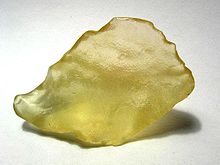Libyan desert glass

Libyan desert glass or Great Sand Sea glass is an
kilometers
.
Geologic origin

The origin of desert glass is uncertain.
tools during the Pleistocene.[11]
The glass is nearly pure silica which requires temperatures above 1,600 °C to form – hotter than any igneous rock on Earth. However, few mineral relics survived from whatever caused the melting, including a form of quartz called
zirconia. Ideas about how the glass formed include melting during meteorite impact, or melting caused by an airburst from an asteroid or other object burning up high in Earth's atmosphere.[12]
See also
- Atacama desert glass – Desert glass found in the Atacama Desert
- Darwin glass – Natural desert glass found in Tasmania
- Edeowie glass – Natural glass found in South Australia
- Hypatia (stone) – Candidate for the first comet nucleus
- Kebira Crater – Circular feature in the Sahara
- Tektite – Gravel-sized glass beads formed from meteorite impacts
- Tunguska event – 1908 meteor air burst explosion in Siberia
References

- ^ "Libyan Desert Glass". mindat.org. Retrieved 12 July 2020.
- ^ Jan Kramers; David Block; Marco Andreoli (2013). "First ever evidence of a comet striking Earth". Wits University. Archived from the original on 2013-10-10.
- Bibcode:1984LPI....15..744S
- S2CID 128920720.
- S2CID 155125330.
- ^ "Desert Glass: An Enigma". Saudi Aramco World.
- ^ "Libyan desert glass mystery solved". cosmosmagazine.com. 23 May 2019. Retrieved 2021-10-21.
- ^ Tut's gem hints at space impact, BBC News, July 19, 2006.
Literature
- V. de Michele (ed.): Proceedings of the Silica '96 Meeting on Libyan Desert Glass and related desert events, Bologna, 1997 Contents
- P.A. Clayton / L.J. Spencer: Silica Glass from the Libyan Desert, Vortrag vom 09.11.1933 online
External links
Wikimedia Commons has media related to Libyan desert glass.
